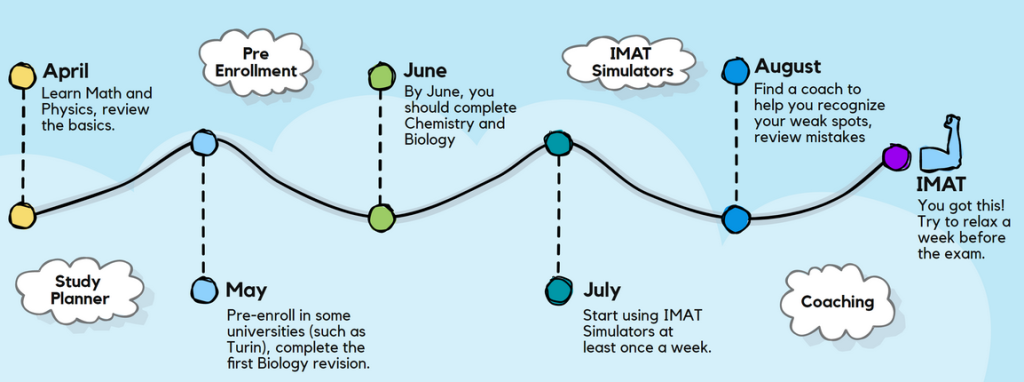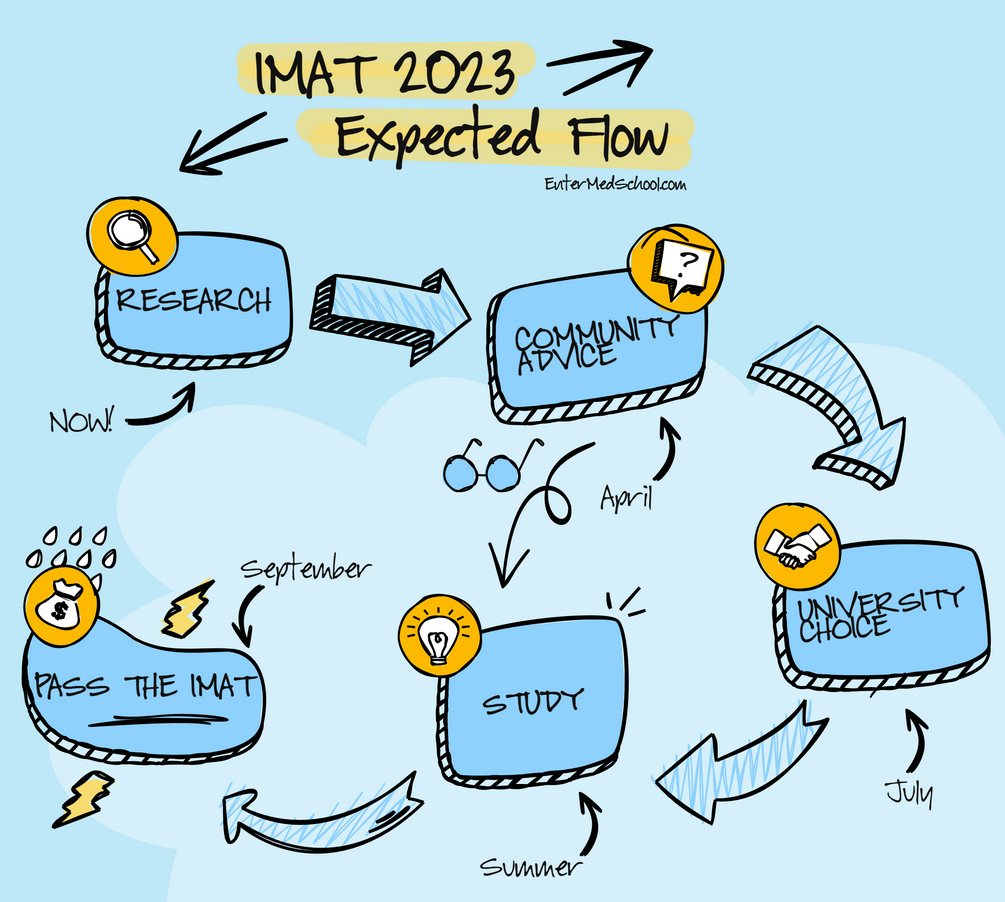

Ari Horesh University of Pavia, Italy
4th of March, 2023If you’re a non-EU student planning to apply for the IMAT exam, you may feel overwhelmed by the complexity of the process. Applying to a foreign university is a big decision, and the application process can seem like a daunting hurdle to overcome. But don’t worry – our comprehensive guide is here to help.
Throughout this article, we’ll guide you step-by-step through the IMAT application process, starting with the basics of what the IMAT is and how it works. We’ll help you understand the key differences between applying to the IMAT as a non-EU student versus applying as an EU student, so that you can make informed decisions about your application strategy.


Hey! If you need help with the pre-enrollment, just join our community! Check the menu for more info, we are here for you!
We’ll cover the various steps of the application process, from registering for the exam to submitting your application and all the required documents. We’ll explain what documents you need to include with your application and how to prepare them, as well as how to navigate the online application system.
Beyond the technicalities of the application process, we’ll also share insights into how you can best position yourself as a non-EU applicant. We’ll cover tips for choosing your universities wisely and provide advice on how to manage your time and stay organized throughout the process.
Finally, we’ll address some common questions and concerns that non-EU students have about the IMAT application process, such as how to find scholarships and how to prepare for the exam. By the end of this article, you’ll have a comprehensive understanding of what it takes to apply to the IMAT as a non-EU student, and you’ll feel confident in taking the next steps towards your academic goals.


Content Quick Navigation
Step 1: Prepare Your Documents
As a non-EU student, preparing your documents for the IMAT application process is a crucial step towards securing your place in your desired university. Between the beginning of April and the end of July, Italian Embassies in Non-EU countries start accepting requests for “Pre-enrollment,” where candidates starting to submit their visa application to their relevant country’s embassy while indicating their first and only choice university.
To make this process smoother, you need to ensure that you have all the necessary legal papers and forms ready before submitting your application. These documents include:
- Form A (Not needed since 2020 but might be needed post-COVID): This form requires you to provide personal information, educational background information, and other relevant details. It was needed in the past, but these days it can be submitted online.
- The Declaration of Value: This document, provided by Italian Embassies globally, reviews your qualifications and confirms your level of education. It’s crucial to get this document early, as it can take some time to process.
- A High School diploma: You’ll need to have your diploma legalized and apostilled from the Ministry of Foreign Affairs and translated if necessary. This step ensures that your diploma is recognized as valid in Italy. Based on your High School diploma, the embassy will create the DoV for you (Declaration of Value)
- A photocopy of a relevant form of ID (Passport, ID, etc.): You’ll also need to provide two passport-sized photos as part of the application process.
Make sure you have all the required documents ready and submit them in a timely manner to avoid delays or complications in the application process. By following these guidelines, you’ll be on your way to a successful IMAT application as a non-EU student.


The “Declaration of Value”
The “Declaration of Value” is a crucial document that must be included in your IMAT application as a non-EU student. It contains essential pieces of information, including the highest level of education you have completed, the number of years you were in formal schooling at any level, and an academic transcript. To ensure that this document is legally recognized, it must be translated into Italian and certified by a notary.
One of the primary requirements for studying medicine in an Italian university is proving that you have completed 12 years of education. The Declaration of Value serves as an official confirmation that you meet this requirement, and it must be issued by the consulate of the country where the institution is based.
It’s important to note that the process of obtaining a Declaration of Value can take some time, so it’s crucial to start the process as early as possible. You’ll need to contact the consulate of your home country and provide them with the necessary documents and information. They will then review your qualifications and provide you with the Declaration of Value.
The Declaration of Value is an essential document that plays a vital role in the IMAT application process for non-EU students, and you will have to obtain it long before the IMAT registration itself, which we will discuss next.
Some Examples to Clarify This Pre-enrollment steps
Here are a few examples to help illustrate the importance of understanding where to obtain the Declaration of Value:
- Sara is a non-EU student who completed her high school education in Egypt. She currently lives in the United Arab Emirates (UAE) and wants to apply to an Italian university to study medicine. To obtain her Declaration of Value, Sara needs to go to the Italian consulate in Egypt, where her high school diploma was issued.
- Amir is a non-EU student who completed his Bachelor’s degree in India. He now lives in the United Kingdom (UK) and wants to apply to an Italian university to pursue a Master’s degree. To obtain his Declaration of Value, Amir needs to go to the Italian consulate in India, as that is where his degree was issued.
- Maria is a non-EU student who completed her high school education in the Philippines. She currently lives in Canada and wants to apply to an Italian university to study economics. To obtain her Declaration of Value, Maria needs to go to the Italian consulate in the Philippines, as that is where her high school diploma was issued.
Registering for the IMAT exam is just the first step in the process of applying to an Italian university as a non-EU student. While registering for the exam may seem like a straightforward process, it’s important to remember that there may be additional steps you need to take to secure your place in your desired university.
If you’re applying for scholarships or requesting a time extension based on a learning disability, you may need to provide translated documents that are not readily available. In such cases, contacting your first choice university, your embassy, and the scholarship body in your first choice university’s region is the best way to confirm which documents you will need to translate during your pre-enrollment. Keep in mind that this process can be lengthy and subject to individual requirements, so it’s essential to start the process as early as possible.
Furthermore, the pre-enrollment process can vary depending on your home country. Asking your corresponding embassy is the best way to know exactly what documents you need to provide in order to complete your pre-enrollment. This step is crucial, as some countries may have unique requirements that you may not be able to fulfil in time if you’re not aware of them in advance. For example, students from Tunisia must complete an Italian Proficiency Certificate of a minimum level to apply for an Italian study visa, whereas other countries may require an English one. To ensure a smooth application process, it’s always best to double-check with your local Italian consulate/embassy.
In summary, the pre-enrollment process can be complicated and subject to individual requirements, so it’s crucial to research and understand the specific requirements for your situation. By contacting the relevant authorities and starting the process early, you’ll be well on your way to a successful IMAT application as a non-EU student.
Step 2: IMAT Registration
Once you have completed the necessary preparations and gathered all the required documents, it’s time to register for the IMAT exam. To do this, you’ll need to have an account on the Universitaly.it website. This account will be your gateway to the IMAT application process, so it’s important to ensure that all your information is accurate and up-to-date.
IMAT registration typically opens in July, and it’s crucial to pay for the exam and register as soon as possible. You can pay in multiple currencies, including around £114.00GBP, €130.00EUR, and $164.00USD, depending on your location and the currency you choose.
It’s worth noting that the IMAT exam for the upcoming academic year (2022-2023) will not be conducted by Cambridge Assessment Admissions Testing due to unforeseen circumstances. The Italian Ministry of Education, Universities, and Research (MIUR) is currently in the process of selecting a new organization to administer the exam. It’s important to keep up-to-date with the latest news and announcements to ensure that you have the most accurate information regarding the registration process and test dates.
After you have completed your registration and payment, you should receive documents approving your registration. It’s crucial to bring these documents with you on the day of the exam, as failure to do so may result in you not being allowed to take the test.
Step 3: Take The Exam
After completing the registration process, the next step is to take the IMAT exam. This can be an overwhelming experience, so it’s important to be well-prepared and know what to expect on the day of the exam.
Each test center has its own specifications on when to arrive, so it’s essential to arrive a few hours before the exam. Bringing food, headphones, a bottle of water without the sticker, the confirmation emails, and the same ID you used when registering for the IMAT exam can help you destress before the exam itself. Taking the time to relax and prepare mentally can help you feel more confident and focused during the exam.
Since the exam will most likely only take place in Italy, it will take place in the morning, which means that you’ll need to adjust accordingly and get used to studying and taking simulators at the same time as the exam. To ensure that you’re mentally and physically prepared for the exam, it’s recommended to make sure to sleep early and well before the exam. This might seem obvious, but it’s crucial to remember that the exam can be an overwhelming experience, and being well-rested can make a significant difference in your performance.
| Items to Bring on Exam Day | Why it’s Important |
| Confirmation emails | To prove that you are registered for the exam and are allowed to take it |
| ID (the same one used for registration) | To verify your identity and ensure that you are the registered candidate |
| Food | To keep your energy levels up and help you focus during the exam |
| Headphones | To block out distractions and help you concentrate on the exam |
| Bottle of water (without a sticker) | To stay hydrated during the exam and help you stay focused |
Items to Bring on IMAT Exam Day
By bringing these essential items on the day of the IMAT exam, you’ll be well-prepared and able to focus on the task at hand. It’s important to note that each exam center may have specific requirements, so it’s always a good idea to double-check with the test center in advance to ensure that you have everything you need on the day of the exam.
Step 4: Enrollment and Visa Application
Once you’ve taken the IMAT exam, you’ll need to wait for the official results to be released, which typically takes around 4 weeks. It’s important to note that non-EU candidates unfortunately don’t have the scrolling system and will only get admitted to their first choice university based on their ranking.
After the official results are released, you’ll have 4-5 days to enroll online to the university you were admitted to based on the official ranking that each university will release. It’s important to complete this process as soon as possible to ensure that you secure your place in the program. After you’ve enrolled in the university, you’ll need to obtain a visa to come to Italy (or stay in Italy if the exam will actually only take place in Italy, in which case the visa process will take place before the IMAT 2023 and not after as in previous years).
The visa application process can take several weeks or even months, so it’s crucial to start this process as soon as possible. Non-EU students typically need a study visa to study in Italy, which requires various documents such as the Declaration of Value, proof of financial means, and a health insurance policy.
Enrolling in the university and obtaining a visa are the final steps in the application process for non-EU students. By ensuring that you enroll as soon as possible and start the visa application process in a timely manner, you’ll be well on your way to starting your academic journey in Italy.

